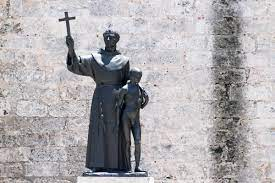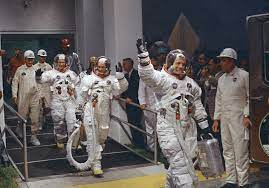The first atomic bomb test is successfully exploded
On July 16, 1945, at 5:29:45 a.m., the Manhattan Project yields explosive results as the first atom bomb is successfully tested in Alamogordo, New Mexico.
Plans for the creation of a uranium bomb by the Allies were established as early as 1939, when Italian emigre physicist Enrico Fermi met with U.S. Navy department officials at Columbia University to discuss the use of fissionable materials for military purposes. That same year, Albert Einstein signed a letter to President Franklin Roosevelt supporting the theory that an uncontrolled nuclear chain reaction had great potential as a basis for a weapon of mass destruction.
In February 1940, the federal government granted a total of $6,000 for research. But in early 1942, with the United States now at war with the Axis powers, and fear mounting that Germany was working on its own uranium bomb, the War Department took a more active interest, and limits on resources for the project were removed.
Brigadier-General Leslie R. Groves, himself an engineer, was now in complete charge of a project to assemble the greatest minds in science and discover how to harness the power of the atom as a means of bringing the war to a decisive end. The Manhattan Project (so-called because of where the research began) would wind its way through many locations during the early period of theoretical exploration, most importantly, the University of Chicago, where Enrico Fermi successfully set off the first fission chain reaction. But the Project took final form in the desert of New Mexico, where, in 1943, Robert J. Oppenheimer began directing Project Y at a laboratory at Los Alamos, along with such minds as Hans Bethe, Edward Teller, and Fermi. Here theory and practice came together, as the problems of achieving critical mass—a nuclear explosion—and the construction of a deliverable bomb were worked out.
Finally, on the morning of July 16, in the New Mexico desert 120 miles south of Santa Fe, the first atomic bomb was detonated. The scientists and a few dignitaries had removed themselves 10,000 yards away to observe as the first mushroom cloud of searing light stretched 40,000 feet into the air and generated the destructive power of 15,000 to 20,000 tons of TNT. The tower on which the bomb sat when detonated was vaporized.
The question now became—on whom was the bomb to be dropped? Germany was the original target, but the Germans had already surrendered. The only belligerent remaining was Japan.
1990S
1995
Amazon opens for business
On July 16, 1995, Amazon officially opens for business as an online bookseller. Within a month, the fledgling retailer had shipped books to all 50 U.S. states and to 45 countries. Founder Jeff Bezos’s motto was “get big fast,” and Seattle-based Amazon eventually morphed into an e-commerce colossus, selling everything from groceries to furniture to live ladybugs, and helping to revolutionize the way people shop.
1990S
1999
JFK Jr. killed in plane crash
On July 16, 1999, John F. Kennedy, Jr.; his wife, Carolyn Bessette Kennedy; and her sister, Lauren Bessette, die when the single-engine plane that Kennedy was piloting crashes into the Atlantic Ocean near Martha’s Vineyard, Massachusetts. John Fitzgerald Kennedy, Jr., was born on November 25, 1960, just a few weeks after his father and namesake was elected the 35th president of the United States. On his third birthday, “John-John” attended the funeral of his assassinated father and was photographed saluting his father’s coffin in a famous and searing image. Along with his sister, Caroline, he was raised in Manhattan by his mother, Jacqueline. After graduating from Brown University and a very brief acting stint, he attended New York University Law School. He passed the bar on his third try and worked in New York as an assistant district attorney, winning all six of his cases. In 1995, he founded the political magazine George, which grew to have a circulation of more than 400,000.
RELIGION
1769
First Catholic mission in California dedicated
Father Junípero Serra, a Spanish Franciscan missionary, founds the first Catholic mission in California on the site of present-day San Diego. After Serra blessed his new outpost of Christianity in a high mass, the royal standard of Spain was unfurled over the mission, which he named San Diego de Alcala. Serra came to Spanish America in 1750 and served in the Sierra Gorda missions and then in south-central Mexico. A successful missionary, he was appointed a member of the second Spanish land expedition to Alta California in 1769. When the party reached San Diego, Serra remained with a few followers to found California’s first mission. The rest of the expedition continued on in search of Monterrey harbor, which had been previously used by Spanish sailors. Although the explorers failed in their aim, Serra succeeded in finding Monterrey in 1770, and there he founded his second mission—San Carlos Barromeo.
SPACE EXPLORATION
1969
Apollo 11 departs Earth
At 9:32 a.m. EDT, Apollo 11, the first U.S. lunar landing mission, is launched on a historic journey to the surface of the moon. After traveling 240,000 miles in 76 hours, Apollo 11 entered into a lunar orbit on July 19. The next day, at 1:46 p.m., the lunar module Eagle, manned by astronauts Neil Armstrong and Edwin “Buzz” Aldrin, separated from the command module, where a third astronaut, Michael Collins, remained. Two hours later, the Eagle began its descent to the lunar surface, and at 4:18 p.m. the craft touched down on the southwestern edge of the Sea of Tranquility. Armstrong immediately radioed to Mission Control in Houston a famous message, “The Eagle has landed.” At 10:39 p.m., five hours ahead of the original schedule, Armstrong opened the hatch of the lunar module. Seventeen minutes later, at 10:56 p.m., Armstrong spoke the following words to millions listening at home: “That’s one small step for man, one giant leap for mankind.” A moment later, he stepped off the lunar module’s ladder, becoming the first human to walk on the surface of the moon.
INVENTIONS & SCIENCE
1935
World’s first parking meter installed
The world’s first parking meter, known as Park-O-Meter No. 1, is installed on the southeast corner of what was then First Street and Robinson Avenue in Oklahoma City, Oklahoma on July 16, 1935. The parking meter was the brainchild of a man named Carl C. Magee, who moved to Oklahoma City from New Mexico in 1927. Magee had a colorful past: As a reporter for an Albuquerque newspaper, he had played a pivotal role in uncovering the so-called Teapot Dome Scandal (named for the Teapot Dome oil field in Wyoming), in which Albert B. Fall, then-secretary of the interior, was convicted of renting government lands to oil companies in return for personal loans and gifts. He also wrote a series of articles exposing corruption in the New Mexico court system, and was tried and acquitted of manslaughter after he shot at one of the judges targeted in the series during an altercation at a Las Vegas hotel.
US GOVERNMENT
1790
Congress declares Washington, D.C. new capital
On July 16, 1790, the young American Congress declares that a swampy, humid, muddy and mosquito-infested site on the Potomac River between Maryland and Virginia will be the nation’s permanent capital. “Washington,” in the newly designated federal “District of Columbia,” was named after the leader of the American Revolution and the country’s first president: George Washington. It was Washington who saw the area’s potential economic and accessibility benefits due to the proximity of navigable rivers.
U.S. PRESIDENTS
2002
President Bush unveils strategy for homeland security
On July 16, 2002, President George W. Bush announces his plan for strengthening homeland security in the wake of the shocking September 11, 2001, terrorist attacks on New York and Washington, D.C., in which nearly 3,000 people had been killed. In the immediate aftermath of the disaster, in an attempt to prevent further bloodshed on American soil, Bush launched a massive overhaul of the nation’s security, intelligence and emergency-response systems through the creation of the White House Office of Homeland Security. It was part of a two-pronged effort, which included pre-emptive military action against terrorists in other countries, to fight the war on terror.
ART, LITERATURE, AND FILM HISTORY
1951
"Catcher in the Rye" is published
J.D. Salinger’s only full-length novel, The Catcher in the Rye, is published by Little, Brown on July 16, 1951. The book, about a confused teenager disillusioned by the adult world, is an instant hit and will be taught in high schools for decades.
NATURAL DISASTERS & ENVIRONMENT
1990
Earthquake wreaks havoc in the Philippines
More than 1,000 people are killed when a 7.7-magnitude earthquake strikes Luzon Island in the Philippines on July 16, 1990. The massive tremor wreaked havoc across a sizeable portion of Luzon, the country’s largest island, with Baguio City suffering the most devastating effects.
CRIME
1979
Jeffrey MacDonald is accused of stabbing his family to death
Jeffrey MacDonald stands trial in North Carolina for the murder of his wife and children nearly 10 years before. Captain MacDonald, an army doctor stationed at Fort Bragg, made an emergency call to military police in the early morning hours of February 17, 1970.
CIVIL WAR
1863
Draft riots continue to rock New York City
The draft riots enter their fourth day in New York City in response to the Enrollment Act, which was enacted on March 3, 1863. Although avoiding military service became much more difficult, wealthier citizens could still pay a commutation fee of $300 to stay at home.
AMERICAN REVOLUTION
1779
Anthony Wayne launches risky attack against British forces
On July 15, 1779, American Brigadier General Anthony Wayne launches a coup de main against British fortifications at Stony Point, New York, on the orders of General George Washington. He earns the moniker “Mad” Anthony Wayne for the ensuing maneuver.
WORLD WAR I
1918
Romanov family executed, ending a 300-year imperial dynasty
In Yekaterinburg, Russia, Czar Nicholas II and his family are executed by the Bolsheviks, bringing an end to the three-century-old Romanov dynasty. Crowned in 1896, Nicholas was neither trained nor inclined to rule, which did not help the autocracy he sought to preserve among a people desperate for change. The disastrous outcome of the Russo-Japanese War led to the Russian Revolution of 1905, which ended only after Nicholas approved a representative assembly–the Duma–and promised constitutional reforms. The czar soon retracted these concessions and repeatedly dissolved the Duma when it opposed him, contributing to the growing public support for the Bolsheviks and other revolutionary groups. In 1914, Nicholas led his country into another costly war—World War I—that Russia was ill-prepared to win. Discontent grew as food became scarce, soldiers became war weary and devastating defeats at the hands of Germany demonstrated the ineffectiveness of Russia under Nicholas.














Comments
Post a Comment